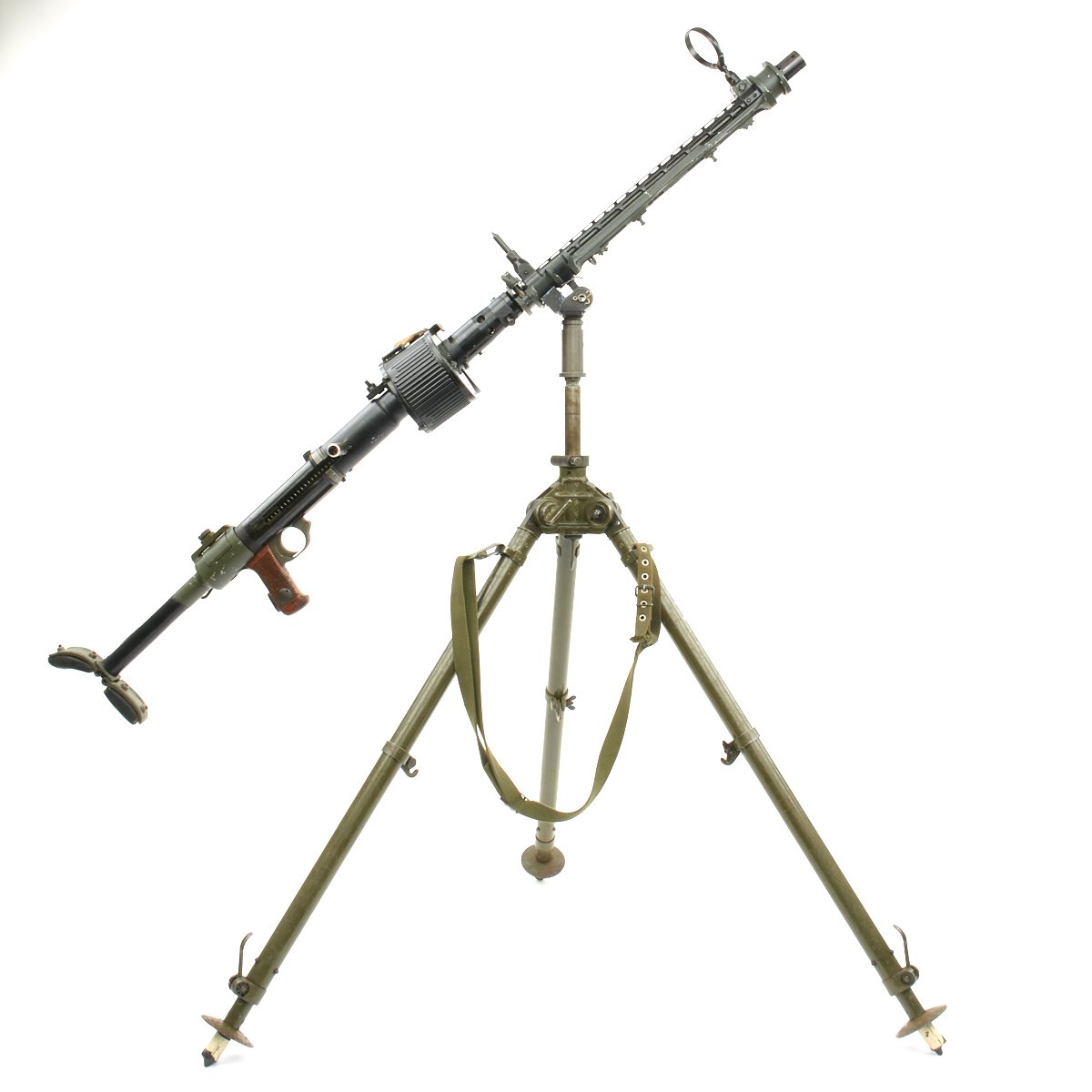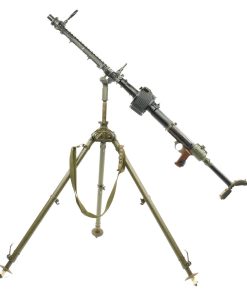Original German WWII Luftwaffe MG 15 Air Cooled Display Gun with Doppel Trommel Magazine and Tripod Original Items
$ 2.995,00 $ 748,75
Original Item: This is the fine rare MG 15 non-firing display gun. Its complete with an original butt stock, original receiver (compliant to BATF specifications with 6 inches of new made solid aluminum), aluminum ventilated jacket bracket and a very rare Doppel Trommel Magazine. All of this sits atop a German Bundeswehr adjustable tripod.
The MG 15 was developed from the MG 30 which was designed by Rheinmetall using the locking system invented by Louis Stange in the mid to late 1920s. Though it shares the MG 15 designation with the earlier gun built by Bergmann, the MG 15nA (for neuer Art, meaning new model having been modified from an earlier design) has nothing in common with the World War II gun except the model number. The World War I gun used a tipping lock system while the WWII aircraft gun uses a rotating bolt/lockring. The World War II MG 15 was used in nearly all Luftwaffe aircraft with a flexible-mount defensive position.
It was a modular design with various attachments that could be quickly attached or removed. Operation was easy and the bolt remained in the cocked position after expending the 75 round double drum (also called a “saddle drum”) magazine, negating the need to re-cock once a fresh magazine was installed.
The MG 15 fires from an open bolt, meaning that the bolt stays back when the gun is ready to fire, and also making it nearly impossible for “through the propeller” synchronized forward firing on a fuselage mount. Pulling the trigger releases the bolt and allows it to go forward, stripping a round from the magazine. The bolt continues pushing the round into the chamber and locks up when the lock-ring rotates and locks the bolt and barrel extension together. At this point the trip lever releases the firing pin and the gun fires. Recoil pushes the barrel, lock and bolt backwards until the lock-ring hits a cam that rotates it unlocking the bolt and barrel. Inertia carries the bolt backwards until the base of the fired case hits the ejector flinging the empty out of the receiver. If the trigger is held down the cycle will continue. If the trigger is released the bolt will remain in the rearward position.
The 75 rounds of ammunition was evenly distributed in each side of the magazine with a central feed “tower” where the ammunition is fed to the bolt. Various methods where used to secure the magazines in the aircraft, while a carrier of 3 mags each were used on ground. The drums were preloaded prior to takeoff so that the gunner did not waste time loading (however reloading could be done as quickly as 6 seconds).[citation needed] Ammunition was fed by a spring forced spiral double-drum containing 75 rounds total (not 150 as is often mistaken). This combined with a firing rate of 1000+ rpm means it could empty the magazine in 4.5 seconds or less. Typical practice was to provide at least 10 reloads for each gun on the aircraft, not including the magazine on the gun.
Starting in late 1940 the MG 15 was replaced by the Mauser 7.92 mm MG 81, MG 81Z (twin-MG 81), MG 131 13 mm machine guns, or MG 151/20 20 mm cannons. Many MG 15s were modified for infantry use as heavier weapons replaced them on Luftwaffe aircraft. There are a number of pictures showing the guns, both aircraft and ground versions, with 25-round magazines from the MG 13 but the magazines don’t actually work with the MG 15. Official numbers of conversions was about 17,648 by January 1, 1944, although additional conversions may have been done as well.
The MG 15 was used in the Japanese aircraft as the Type 98 flexible-mounted machine gun and as the Type 1 in the Imperial Japanese Navy.
Fast Shipping with Professional Packaging
Thanks to our longstanding association with UPS FedEx DHL, and other major international carriers, we are able to provide a range of shipping options. Our warehouse staff is expertly trained and will wrap your products according to our exact and precise specifications. Prior to shipping, your goods will be thoroughly examined and securely secured. We ship to thousands clients each day across multiple countries. This shows how we're dedicated to be the largest retailer on the internet. Warehouses and distribution centres can be located throughout Europe as well as the USA.
Note: Orders with more than one item will be assigned a processing date depending on the item.
Before shipping before shipping, we'll conduct a thorough inspection of the items you have ordered. Today, the majority of orders will be delivered within 48 hours. The delivery time will be between 3-7 days.
Returns
The stock is dynamic and we cannot completely manage it because multiple stakeholders are involved, including our factory and warehouse. So the actual stock may alter at any time. It's possible that you may not receive your order once the order has been made.
Our policy is valid for a period of 30 days. If you don't receive the product within 30 days, we are not able to issue a refund or an exchange.
You can only return an item if it is unused and in the same state as the day you received it. You must have the item in its original packaging.
Related products
Uncategorized
Uncategorized
Uncategorized
Uncategorized
Uncategorized
Uncategorized
Uncategorized
Uncategorized
Uncategorized
Uncategorized
Armored Burgonet Helmet & Polearm from Scottish Castle Leith Hall Circa 1700 Original Items
Uncategorized
Australian WWII Owen MK1 Machine Carbine SMG Custom Fabricated Replica with Sling Original Items
Uncategorized
Uncategorized
Uncategorized
Uncategorized
Uncategorized
Uncategorized
Uncategorized
Uncategorized













































































